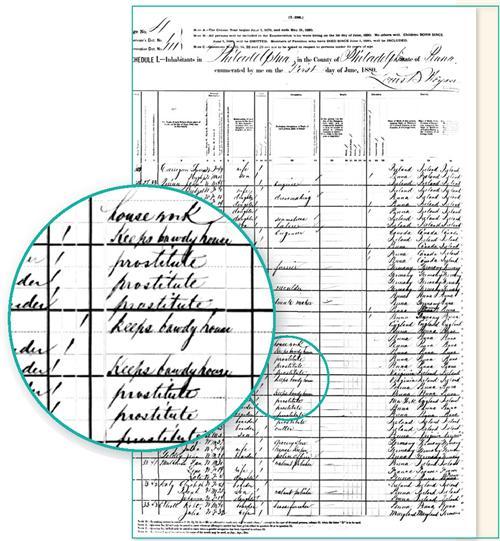Sign up for the Family Tree Newsletter Plus, you’ll receive our 10 Essential Genealogy Research Forms PDF as a special thank you!
Get Your Free Genealogy Forms
"*" indicates required fields

If one of these words appears by your ancestor’s name, you might wonder what led her to that means of supporting herself. People then had bad luck and made questionable choices just as they do today. The husbands of prostitutes in the 1870 or 1880 census, for example, may have been killed in the Civil War.
For the most part, US censuses counted prostitutes the same as anyone else: In the 1870 enumeration for Ohio’s rural Van Wert County, Susanna Stevenson, age 35, is listed as a prostitute, as is her 16-year-old daughter, Nancy, and 25-year-old neighbor Anna Myers. In some cases, though, you may have to read between the lines. The 1860 Yreka County, Calif., census lists a residence of Chinese women (each recorded simply as China Woman) ages 19 and 20, all with the occupation unknown. (The same census taker recorded miners as John Chinaman.)
You can trace a prostitute in city directories, too, sometimes with the address of the “houses of ill fame” where she worked. City police blotters — summaries of police actions — also may give clues. In June 1879, the Toledo, Ohio, blotter listed Ida Bruce, age 24, accused of prostitution. Following was an entry for 30-year-old John Higdon, a barber, charged with “visiting rooms for prostitution.” Toledo police blotters are in books at the local library; historical societies and city archives are other likely locations for blotters or jail registers.
Research newspapers, too. In Toledo Oct 11, 1879, police raided two residences suspected as prostitution sites, arresting seven women and three men. Two days later, the Toledo Blade gossip page reported “five women were charged with keeping houses of ill fame, five were charged with being inmates of such houses and four men were accused of visiting the same … It is probable that some of the worst dens in the City will be extinguished by the result of the trials.” They might’ve been successful, as these women aren’t in Toledo’s 1880 census.
ADVERTISEMENT

